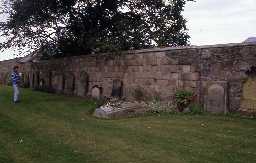The Master of Bamburgh's Tower (Bamburgh)
In a list of towers compiled in 1460 mention is made of a tower belonging to the master of Bamburgh. The base of this tower may still be plainly observed in a wall separating the churchyard from the house called Bamburgh Hall. It is about 33 feet in length, with masonry of a very solid character, and projects a short distance beyond the rest of wall into which it is built. (1)
NU 17883496. A portion of the wall on the east side of the churchyard is of large blocks of dressed masonry with a plinth course on the west side. The stretch of wall thus constructed is 10m long and 0.8m thick. There are no architectural features visible and no trace of foundations are to be seen in the garden to the east. The wall is 2.2m high. See photograph. (2)
As described. (3)
Condition unchanged. (4)
Churchyard wall and gateway east and south of Church of St Aidan, grade II listed building. Medieval and 18th century. A 15 yards section of the wall east of the church has a chamfered plinth and large medieval squared stone and is said to be the remains of The Master of Bamburgh's Tower. (5)
The lower part of the west wall of a substantial medieval building, incorporated in the east wall of the churchyard of St Aidan's Church, has been identified as the 'Touris de Bambruigh' referred to in the 1415 list as belonging to the Master of Bamburgh (ie the master of the cell of Austin canons).
The north end of the surviving section of wall is more or less in line with the south wall of the chancel of the parish church. The wall is 10.1m long and stands 2.2m high, consisting of seven courses of pink and yellow sandstone ashlar (in some courses the different colours seem to alternate) above a chamfered plinth; the plinth does not appear to return at either end. This section of wall is set forward c.0.3m from the wall on either side, which appears to be of 18th century date; on the east side of the wall (towards the garden on Bamburgh Hall) there seems to have been extensive rebuilding or refacing and the earlier section is difficult to distinguish from the remainder. The thickness if the medieval section of wall is hard to determine, but is probably a little less than 1m.
In its present condition the surviving wall seems a little thin to be part of a tower, although its east face may well have been cut back. It certainly looks of medieval date, but might be part of some monastic building other than the tower, such as existed at the Benedictine cells of Coquet Island and Farne. (6)
Listed by Cathcart King. (7a)
NU 17883496. A portion of the wall on the east side of the churchyard is of large blocks of dressed masonry with a plinth course on the west side. The stretch of wall thus constructed is 10m long and 0.8m thick. There are no architectural features visible and no trace of foundations are to be seen in the garden to the east. The wall is 2.2m high. See photograph. (2)
As described. (3)
Condition unchanged. (4)
Churchyard wall and gateway east and south of Church of St Aidan, grade II listed building. Medieval and 18th century. A 15 yards section of the wall east of the church has a chamfered plinth and large medieval squared stone and is said to be the remains of The Master of Bamburgh's Tower. (5)
The lower part of the west wall of a substantial medieval building, incorporated in the east wall of the churchyard of St Aidan's Church, has been identified as the 'Touris de Bambruigh' referred to in the 1415 list as belonging to the Master of Bamburgh (ie the master of the cell of Austin canons).
The north end of the surviving section of wall is more or less in line with the south wall of the chancel of the parish church. The wall is 10.1m long and stands 2.2m high, consisting of seven courses of pink and yellow sandstone ashlar (in some courses the different colours seem to alternate) above a chamfered plinth; the plinth does not appear to return at either end. This section of wall is set forward c.0.3m from the wall on either side, which appears to be of 18th century date; on the east side of the wall (towards the garden on Bamburgh Hall) there seems to have been extensive rebuilding or refacing and the earlier section is difficult to distinguish from the remainder. The thickness if the medieval section of wall is hard to determine, but is probably a little less than 1m.
In its present condition the surviving wall seems a little thin to be part of a tower, although its east face may well have been cut back. It certainly looks of medieval date, but might be part of some monastic building other than the tower, such as existed at the Benedictine cells of Coquet Island and Farne. (6)
Listed by Cathcart King. (7a)
N5258
FIELD OBSERVATION, Ordnance Survey Archaeology Division Field Investigation 1955; E Geary
FIELD OBSERVATION, Ordnance Survey Archaeology Division Field Investigation 1964; W D Johnston
FIELD OBSERVATION, Ordnance Survey Archaeology Division Field Investigation 1968; D Smith
FIELD OBSERVATION, Ordnance Survey Archaeology Division Field Investigation 1964; W D Johnston
FIELD OBSERVATION, Ordnance Survey Archaeology Division Field Investigation 1968; D Smith
Disclaimer -
Please note that this information has been compiled from a number of different sources. Durham County Council and Northumberland County Council can accept no responsibility for any inaccuracy contained therein. If you wish to use/copy any of the images, please ensure that you read the Copyright information provided.
